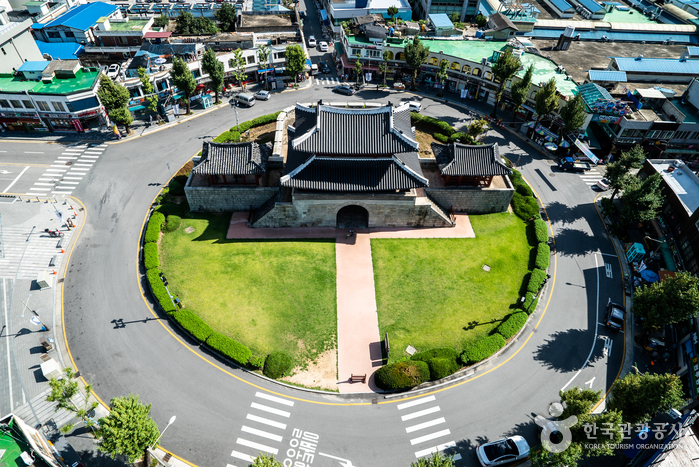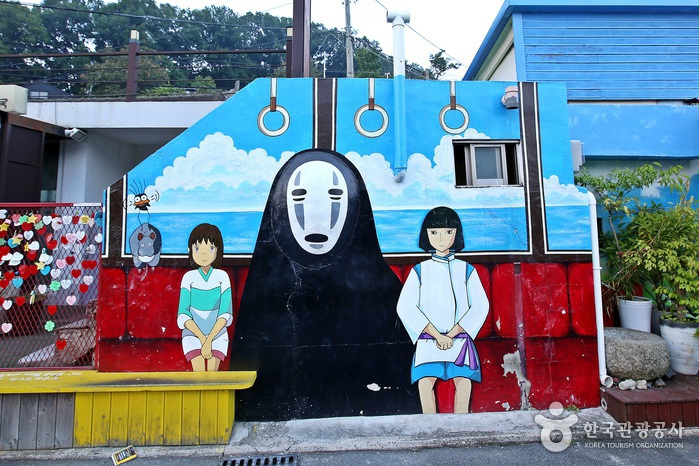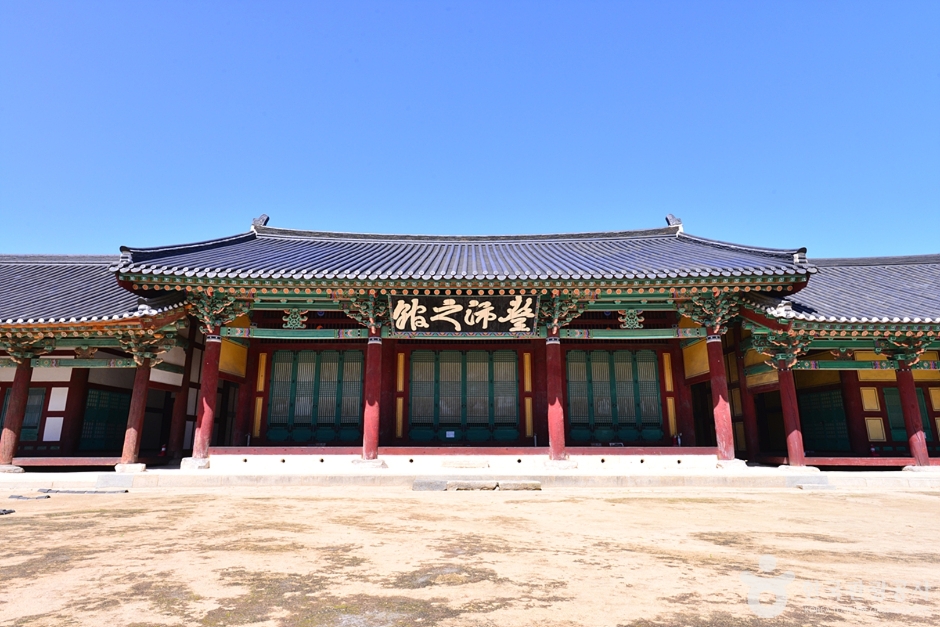Jeonju Pungnammun Gate (전주 풍남문)
642.9940855948138m 29322 2024-05-27
1 Pungnammun 3-gil, Wansan-gu, Jeonju-si, Jeonbuk-do
+82-63-287-6008
Pungnammun Gate was built during the Joseon dynasty in 1734 and is a designated Treasure. Pungnammun Gate was the southernmost gate among the four city gates of Jeonju. The structure was severely damaged by fire in 1767, followed by the restoration of the gate tower afterward. The gate was burnt down once again during the Imjin War and was restored to the gate that is seen today.
Jaman Mural Village (자만벽화마을)
650.9973021383569m 1664 2024-04-07
1-10, Jamandong 1-gil, Wansan-gu, Jeonju-si, Jeonbuk-do
Jaman Mural Village is located in the ridge between Omokdae and Imokdae along the foot of Seungamsan Mountain’s Jungbawi Rock. Jeonju Hanok Village is also visible from the wide street. Although it is a fairly steep walk up to Jaman Village, visitors will be able to enjoy colorful murals painted on the buildings and walls along the way.
Jaman Mural Village (자만마을 벽화갤러리)
651.7182586975588m 1 2024-05-02
Gyo-dong, Wansan-gu, Jeonju-si, Jeonbuk-do
Jaman Mural Village is located on a hillside across the road from Jeonju Hanok Village. The village was formed by Korean war refugees resettling where they could, and remained as a small village interlaced by narrow pathways until 2012. At that point, the village was enlivened with over 40 murals and became popular for photographs. Many of the houses have been converted into cafes, guesthouses, and restaurants.
Jeonju Jeondong Catholic Cathedral (전주전동성당)
656.9527961154026m 52001 2024-05-27
51 Taejo-ro, Wansan-gu, Jeonju-si, Jeonbuk-do
Jeondong Catholic Cathedral in Jeonju was built in honor of Roman Catholic martyrs of the Joseon dynasty on the very same spot the martyrs lost their lives. The land was purchased by French Priest Baudenet in 1891 (28th year of King Gojong), but construction of the church did not begin until 1908. Construction was completed in 1914, a time during which Korea was under Japanese rule. Though originally built just outside of Pungnammun Gate, the site of the martyrs, the church was later moved to its current location for expansion.
The first Romanesque building in the Honam region, Jeondong Catholic Cathedral is made of gray and red bricks and bears a striking resemblance to the Myeongdong Cathedral in Seoul, also designed by Priest Poinel. Not only considered one of the most beautiful Catholic churches in Korea, some even go so far as to say it is one of the most beautiful structures in all of Korea, citing the church’s unique combination of Byzantine and Romanesque architectural styles. The rectangular building is topped with three Byzantine bell towers (to the right, center, and left) and boasts arched ceilings, several of which meet in the form of a cross.
It is interesting to note that some of the bricks used in construction of the church were made using materials from the Jeonjueupseong Walled Town, which was torn down by the Japanese. It is also said that the cornerstone of the church came from a wall of Jeonjueupseong Walled Town near Pungnammun Gate.
ABC-Mart - Jeonjugaeksa Branch [Tax Refund Shop] (ABC마트 MS전주객사)
656.876707708039m 0 2024-04-23
38-1, Jeonjugaeksa 5-gil, Wansan-gu, Jeonju-si, Jeollabuk-do
-
Jeonju Pungpaejigwan Guesthouse (전주 풍패지관 (전주객사))
662.327312648849m 34178 2024-05-27
59 Chunggyeong-ro, Wansan-gu, Jeonju-si, Jeonbuk-do
During the Joseon dynasty, officials and envoys visiting Jeonju stayed here. Today, it is open for anyone to see. The long and spacious maru (wooden central space) is open to the public, making it a comfortable resting place for citizens and tourists. Located in downtown Jeonju, it is easy to find and close to Jeonju Hanok Village.
Siwon [Korea Quality] / 시원 [한국관광 품질인증]
666.8806108313559m 11550 2024-04-07
45-41 , Omokdae-gil, Wansan-gu, Jeonju-si, Jeonbuk-do
+82-10-6520-7840
Siwon is a timber and clay-built hanok stay, part of Jeonju Hanok Village in Jeollabuk-do. It has four guestrooms, all but one with a small attic - so guests can have fun climbing up and down the ladder! The rooms have all been insulated and draft-proofed to keep visitors warm and comfortable. In the yard is a small garden and swing, and guests can play traditional games such as Tuho and Jegichagi - or even take part in a carpentry workshop. Must-see sites such as Gyeonggijeon, Jeondong Cathedral, Omokdae, and Nambu Market can all be reached on foot.
Ladam [Korea Quality]라담[한국관광 품질인증]
670.2603770930575m 1 2024-04-07
83-9 , Eunhaeng-ro, Wansan-gu, Jeonju-si, Jeonbuk-do
+82-504-0904-2593
Ladam is a private hanok stay that stands on Eunhaeng-ro Street in the center of Jeonju Hanok Village, Jeollabuk-do. It is rented out as a single house, and the bedroom is equipped with a queen-size bed and top-quality bedding. Guests wishing to explore the Hanok Village will find everything is just a short walk away.
Olive Young - Jeonju NC WAVE Branch [Tax Refund Shop] (올리브영 전주엔씨웨이브)
676.9053574212361m 0 2024-04-22
35, Jeonjugaeksa 5-gil, Wansan-gu, Jeonju-si, Jeollabuk-do
-
Yedawon [Korea Quality] / 예다원 [한국관광 품질인증]
684.7552131025657m 184 2024-04-07
85-34 , Hyanggyo-gil, Wansan-gu, Jeonju-si, Jeonbuk-do
+82-63-228-8218, +82-10-3376-8987
Positioned at the foot of Omokdae in Jeonju, Jeollabuk-do, Yedawon is a hanok stay which offers guests a unique experience of traditional hanok life. Guestrooms have exposed timbers, walls lined with Korean paper, and framed works of calligraphy. The Lotus Room boasts a beautiful 8-panel folding screen with painted landscape, and large ink-and-wash artworks on the wall. The traditional experience program includes tea ceremonies, natural dyeing, hanji making and rice-cake making. Jeonju Hyanggyo Confucian School, Jeonju Hanbyeok Cultural Cente and Gyeonggijeon Shrine are all reachable on foot.





![Siwon [Korea Quality] / 시원 [한국관광 품질인증]](http://tong.visitkorea.or.kr/cms/resource/24/2596624_image2_1.jpg)
![Ladam [Korea Quality]라담[한국관광 품질인증]](http://tong.visitkorea.or.kr/cms/resource/64/2948864_image2_1.jpg)
![Olive Young - Jeonju NC WAVE Branch [Tax Refund Shop] (올리브영 전주엔씨웨이브)](http://tong.visitkorea.or.kr/cms/resource/67/2886367_image2_1.jpg)
![Yedawon [Korea Quality] / 예다원 [한국관광 품질인증]](http://tong.visitkorea.or.kr/cms/resource/91/2594991_image2_1.jpg)
 English
English
 한국어
한국어 日本語
日本語 中文(简体)
中文(简体) Deutsch
Deutsch Français
Français Español
Español Русский
Русский